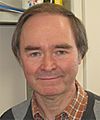Parapsychology facts for kids
Parapsychology is the study of psychic events. These are things that seem to happen without using our normal five senses (sight, smell, hearing, touch, and taste). It includes ideas like extrasensory perception (ESP), which is knowing things without seeing or hearing them. It also covers how the mind might affect objects (psychokinesis). Other topics are strange experiences like remembering past lives or near-death experiences. People have reported these kinds of events for a very long time.
Some scientists, like Nobel Prize winner Brian Josephson, say that many scientists are not convinced by the evidence for parapsychology. Josephson believes that some scientists feel uncomfortable with ideas like telepathy. He thinks their feelings can sometimes stop them from looking at the evidence fairly.
Contents
Understanding Parapsychology Terms
- Telepathy: This is when information is shared between minds without using the five senses. It's like mind-to-mind communication.
- Precognition: This means knowing about future events before they happen.
- Clairvoyance: This is getting information about faraway places or events without being there.
- Psychokinesis: This is the idea that a person's mind can influence things outside their body. This could include moving objects or affecting energy.
- Near death experience: This is when someone who was close to death describes experiences like seeing a bright light or leaving their body.
- Reincarnation: This is the belief that a person's soul or consciousness is reborn into a new body after death.
- Apparitional Experience: This is when people believe they have seen or felt a spirit or something paranormal.
Why People Might Believe in Psychic Events
How Our Brains See Patterns
Psychologist Michael Shermer created a theory called Belief Dependent Realism. It suggests that our brains are always looking for patterns to understand the world. Sometimes, our minds find patterns even when there aren't any real ones. This is called Paternicity.
Paternicity is our brain's tendency to see connections that don't actually exist. When this happens, people might start to see the world based on these false patterns.
Quick Thinking Shortcuts (Heuristics)
Heuristics are mental shortcuts our brains use to make quick decisions. They help us deal with a lot of information without thinking too hard. However, these shortcuts can sometimes lead us to wrong conclusions.
Types of Thinking Shortcuts
One type of shortcut is called Anchoring and Adjustment. With this, a person makes an educated guess first. Then, as they learn new information, they adjust their answer around their first guess.
Psychologists Amos Tversky and Daniel Kahneman first studied this. In one experiment, they asked two groups to guess the answer to a math problem.
The problems were:
- 1x2x3x4x5x6x7x8
- 8x7x6x5x4x3x2x1
The first number in each problem acts as an "anchor." The group given the first problem (starting with 1) guessed much lower. Their average guess was 512. The group given the second problem (starting with 8) guessed higher, with an average of 2,250. Both guesses were very far from the correct answer, which is 40,320. This shows how the starting number influenced their final guess.
Another shortcut is the Availability Heuristic. This is when you answer a question based on how easily examples come to your mind. For example, if you live in a neighborhood with a lot of crime, you might think there are more robberies in the whole country than there actually are.
Other pages
Images for kids
-
Photographs that purportedly depicted ghosts or spirits were popular during the 19th century.
See also
 In Spanish: Parapsicología para niños
In Spanish: Parapsicología para niños







